
International Committee for Future
Accelerators (ICFA)
Standing Committee on Inter-Regional
Connectivity (SCIC)
Chairperson: Professor Harvey Newman, Caltech
ICFA SCIC Network Monitoring Report
Prepared by the ICFA SCIC Monitoring Working
Group
On behalf of the Working Group:
Les Cottrell cottrell@slac.stanford.edu
Internet performance is improving each year with packet losses typically
improving by 40-50% per year and Round Trip Times (RTTs) by 10-20% and, for some
regions such as S. E. Europe, even more. Geosynchronous satellite connections are
still important to countries with poor telecommunications infrastructure. In
general for HEP countries satellite links are being replaced with land-line
links with improved performance (in particular for RTT).
Links between the more developed regions including Anglo America, Japan and
Europe are much better than elsewhere (5 - 10 times more throughput achievable).
Regions such as S.E. Europe, Central Asia and Russia are catching up with the more developed regions
(at the present rate of progress they should catch up by the end of the decade). However, China,
the Middle East, Latin America and Africa are several years behind in
performance compared to the more developed regions, and do not appear to be
catching up. Even worse India appears to be falling further behind.
For modern HENP collaborations and Grids there is an increasing need for
high-performance monitoring to set expectations, provide planning and
trouble-shooting information, and to provide steering for applications
To quantify and help bridge the Digital Divide, enable world-wide
collaborations, and reach-out to scientists world-wide, it is imperative to
continue and extend the monitoring coverage to all countries with HENP programs
and significant scientific enterprises. This in turn will require help from ICFA
to identify sites to monitor and contacts for those sites, plus identifying
sources of on-going funding support to continue and extend the monitoring.
The formation of this working group was requested at the ICFA/SCIC
meeting at CERN in March 2002 [icfa-mar02]. The mission is to: Provide
a quantitative/technical view of inter-regional network performance to enable
understanding the currrent situation and making recommendations for improved
inter-regional connectivity.
The lead person for the monitoring working group was identified as Les
Cottrell. The lead person was requested to gather a team of people to assist in
preparing the report and to prepare the current ICFA report for the end of 2002.
The team membership consists of:
| Les Cottrell |
SLAC |
US |
cottrell@slac.stanford.edu |
| Richard Hughes-Jones |
University of Manchester |
UK |
rich@a3.ph.man.ac.uk |
| Sergei Berezhnev |
RUHEP, Moscow State.Univ. |
Russia |
sfb@radio-msu.net |
| Sergio F. Novaes |
FNAL |
S. America |
novaes@fnal.gov |
| Fukuko Yuasa |
KEK |
Japan and E. Asia |
Fukuko.Yuasa@kek.jp |
| Sylvain Ravot |
Caltech |
CMS |
Sylvain.Ravot@cern.ch |
| Daniel Davids |
CERN |
CERN, Europe, LHC |
Daniel.Davids@cern.ch |
| Shawn McKee |
Michigan |
I2 HENP Net Mon WG |
smckee@umich.edu |
- Obtain as uniform picture as possible of the present performance of the
connectivity used by the ICFA community
- Prepare reports on the performance of HEP connectivity,
including, where possible, the identification of any key bottlenecks or
problem areas.
This report may be regarded as a follow on to the May 1998 Report of the
ICFA-NTF Monitoring Working Group [icfa-98] and the
January
2003 Report of the ICFA-SCIC Monitoring Working Group [icfa-03]. The current report
updates the January 2003 report, but is complete in its own right in that it
includes the tutorial information from the January 2003 report.
There are two complementary types of Internet monitoring
reported on in this report.
- In the first we use PingER [pinger] which
uses the ubiquitous "ping" utility available standard on most modern hosts.
Details of the PingER methodology can be found in the May 1998 Report of the
ICFA-NTF Monitoring Working Group [icfa-98] and [ejds-pinger]. PingER provides low
intrusiveness (~ 100bits/s per host pair monitored1) Round Trip Time (RTT),
loss, reachability (if a host does not respond to a set of 21 pings it is
presumed to be non-reachable). The low intrusiveness enables the method to be
very effective for measuring regions and hosts with poor connectivity. Since
the ping server is pre-installed on all remote hosts of interest, minimal
support is needed for the remote host (no software to install, no account
needed etc.)
- The second method (IEPM-BW
[iepm]) is for measuring high network and application throughput between
hosts with excellent connections. Examples of such hosts are to be found at
HENP accelerator sites and tier 1 and 2 sites, major Grid sites, and major academic and
research sites in Anglo America2, Japan and Europe. The method is
quite intrusive (for each remote host being monitored from a monitoring host,
it can utilize hundreds of Mbits/s for ten seconds or more each hour). It also
requires more support from the remote host. In particular an account is
required, software (servers) must be installed, disk space, compute cycles
etc. are consumed, and there are security issues. The method provides
expectations of throughput achievable at the network and application levels,
as well as information on how to achieve it, and trouble-shooting
information.
The PingER data and results extend back to the start of 1995. They thus
provide a valuable history of Internet performance. There (December 2003) are about 33
monitoring hosts in 12 countries, monitoring over 850 remote hosts at 560 sites
in over 100 countries (see PingER
Deployment [pinger-deploy]). These countries contain over 78% of the world's
population and over 90% of the online users of the Internet. Most of the
hosts monitored are at educational or research sites. We try and get at least 2
hosts per country to help identify and avoid anomalies at a single host. The
requirements for
the remote host can be found in [host-req].
Since there are over 3700 monitoring/monitored-remote-host pairs, it is important to
provide aggregation of data by hosts from a variety of "affinity groups". PingER
provides aggregation by affinity groups such as HENP experiment
collaborator sites, Top Level Domain (TLD), Internet Service Provider
(ISP), or by world region etc. The world regions are shown below in Table 1.
They are chosen starting from the U.N. definitions [un]. We
modify the region definitions to take into account which countries have HENP
interests and to try and ensure the countries in a region have similar
performance. The regions and countries monitored by PingER are shown in Fig. 1,
together with the monitoring and archive sites.
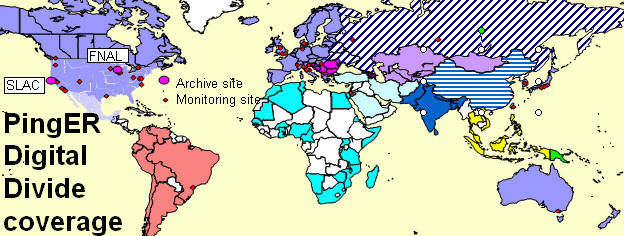
|
|
Figure 1: Major regions of the world for PingER
aggregation by regions |
The major regions are: Anglo America (2), Latin America (14), Europe (24), S.E. Europe
(9),
Africa (21), Mid East (7), Caucasus (3), Central Asia (8), Russia includes
Belarus & Ukraine (3), S. Asia (7), China (1) and
Australasia (2). The numbers in parentheses are the number of countries
monitored by PingER in the region.. We also subdivide regions at times to provide better granularity. The major sub-regions are
obtained by separating: Central America and the Carribean (5) from S. America
(9); Israel from the Mid-East, the Baltic States from Europe. For the purposes
of characterizing the Digital Divide we also aggregate Anglo America, Europe,
Australasia, Japan, Taiwan and S. Korea into the Developed Countries..
To assist in interpreting the results in terms of their impact on well-known
applications, we categorize the RTTs, losses etc. into quality ranges.
These are shown below in Table 2.
Table 2: Quality ranges used for loss and RTT
| |
Excellent |
Good |
Acceptable |
Poor |
Very Poor |
Bad |
| Loss |
<0.1% |
>=0.1% & &
< 1% |
> =1%
& < 2.5% |
>= 2.5%
& < 5% |
>= 5%
& < 12% |
> 12% |
| RTT |
|
<62.5ms |
>=62.5ms
& < 125ms |
>= 125ms
& < 250ms |
>=250ms
& < 500ms |
>500ms |
More on the effects of packet loss and
RTT can be found in the Tutorial
on Internet Monitoring & PingER at SLAC [tutorial], briefly:
- At losses of 4-6% or more video-conferencing becomes irritating and
non-native language speakers become unable to communicate. The occurrence of
long delays of 4 seconds (such as may be caused by timeouts in recovering from
packet loss) or more at a frequency of 4-5% or more is also irritating for
interactive activities such as telnet and X windows. Conventional wisdom
among TCP researchers holds that a loss rate of 5% has a significant adverse
effect on TCP performance, because it will greatly limit the size of the
congestion window and hence the transfer rate, while 3% is often substantially
less serious, Vern Paxson. A random loss of 2.5% will result in Voice
Over Internet Protocols (VOIP) becoming slightly annoying every 30 seconds or
so. A more realistic burst loss pattern will result in VOIP distortion going
from not annoying to slightly annoying when the loss goes from 0 to 1%. Since
TCP throughput for the standard (Reno based) TCP stack goes as 1/(sqrt(loss)
[mathis]) (see M. Mathis, J. Semke, J. Mahdavi, T. Ott, "The Macroscopic
Behavior of the TCP Congestion Avoidance Algorithm",Computer
Communication Review, volume 27, number 3, pp. 67-82, July 1997), it is
important to keep losses low for achieving high throughput.
- For RTTs, studies in the late 1970s and early 1980s showed that one needs
< 400ms for high productivity interactive use. VOIP requires a RTT of <
250ms or it is hard for the listener to know when to speak.
It must be
understood that these quality designations apply to normal Internet use. For
high performance, and thus access to data samples and effective partnership in
distributed data analysis, much lower packet loss rates may be required.
Loss
Of the two metrics loss & RTT, loss is more critical since a loss of a
packet will typically cause timeouts that can last for several seconds. Fig. 2
shows the loss measured from ESnet sites (ANL, BNL, DoE, ESnet NOC, FNAL, LANL,
& SLAC) to various regions of the world.
|
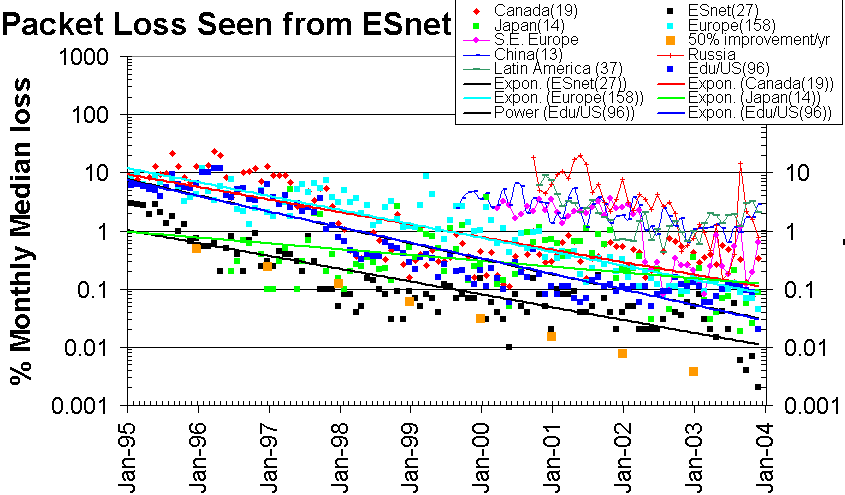 |
|
Figure 2: Monthly packet loss as a function of time, seen
from ESnet sites to various regions of the world. The numbers in
parentheses indicate the number of monitor site / remote site pairs
contributing to the medians. The orange dots show 50%
improvement/year. |
The following observations can be made:
- The improvement in losses is about 10-50% per year.
- The best networks are achieving better than 0.1% packet for most of their
sites seen from ESnet.
- Russia, S.E. Europe and China are several years behind Europe and
Anglo America.
Another way of looking at the losses is to see how many hosts fall in the
various loss quality categories defined above as a function of time. An example
of such a plot is seen in Fig 3.
|
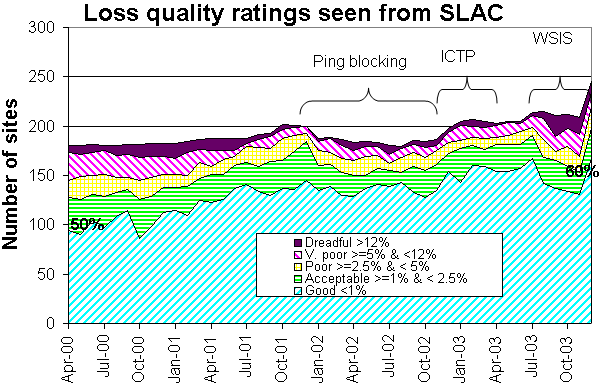 |
|
Figure 3: Number of hosts measured from SLAC for each
quality category from Jan 2000 through December 2003. |
It can be seen that recently most sites fall in the good quality category.
Also the number of sites with good quality has increased from about 50% to about
60% in the the
2.5 years displayed. The plot also shows the total number of hosts monitored
from SLAC at various times. Towards the end of 2001 the number started dropping
as sites blocked pings due to security concerns. The rate of blocking is such
that out of 214 host that were pingable in July 2003, 33 (~15%) were no longer pingable in December 2003.
The increases towards the end of 2002 and early 2003 was due to help from the
Abdus Salam Institute of Theoretical Physics (ICTP). The ICTP held a Round Table meeting on Developing
Country Access to On-Line Scientific Publishing: Sustainable Alternatives
[ictp] in Trieste in November 2002 that included a Proposal
for Real time monitoring in Africa [africa-rtmon]. Following the meeting a
formal declaration was made on RECOMMDENDATIONS
OF the Round Table held in Trieste to help bridge the digital divide
[icfa-rec]. The PingER project is collaborating with the ICTP to develop a
monitoring project aimed at better understanding and quantifying the Digital
Divide. On December 4th the ICTP electronic Journal Distribution Service (eJDS)
sent an email entitled Internet
Monitoring of Universities and Research Centers in Developing Countries
[ejds-email] to their collaborators informing them of the launch of the
monitoring project and requesting participation. By January 14th 2003, with the
help of ICTP, we added about 23 hosts in about 17 countries including:
Bangladesh, Brazil, China, Columbia, Ghana, Guatemala, India (Hyderabad and Kerala), Indonesia, Iran, Jordan, Korea, Mexico, Moldova, Nigeria, Pakistan,
Slovakia and the Ukraine.
The increase towards the end of 2003 was spurred by preparations for the
second Open Round Table on
Developing Countries Access to Scientific Knowledge: Quantifying the Digital
Divide 23-24 November Trieste, Italy and the WSIS conference and
associated activities in
Geneva December 2003.
Fig. 4 shows the world's connected population fractions obtained by dividing countries up
by loss quality seen from the US, and adding the connected populations for the countries
(we obtained the population/country figures from "How many Online" [nua])
for a given loss quality to get a fraction compared to the total world's
connected population.
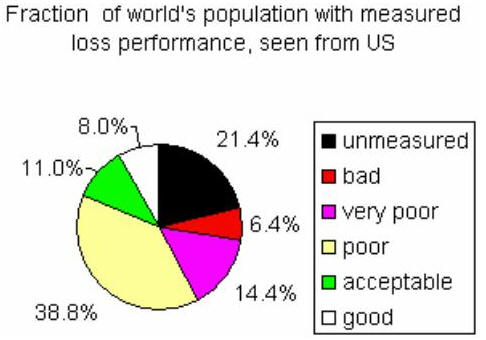 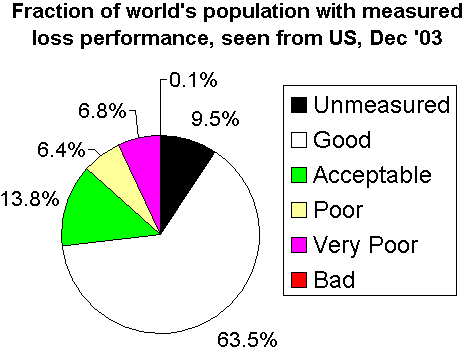 |
| Figure 4: Fraction of the world's connected population in
countries with measured loss performance in 2001 and Dec '2003 |
It can be seen that in 2001, <20% of the population lived in countries
with good to acceptable packet loss. By December 2003 this had risen to 75%. The
coverage of Pinger has also increased from about 70 countries at the start of
2003 to over 100 in January 2004. This in turn reduced the fraction of the
connected population for which PingER has no measurements.
RTTs
Unfortunately there are limits to the minimum RTT due to the speed of light
in fibers or electricity in copper. Typically today, the minimum RTTs for
terrestrial circuits are about 2 * distance / (0.6 * (0.6 * c)), where
c is the velocity of light, the factor of 2 accounts for the round-trip,
0.6*c is roughly the speed of light in
fiber and the extra 0.6 allows roughly for the delays in network equipment such
as routers. For geostationary satellites links the minima are between 500 and
600ms. For U.S. cross country links (e.g. from SLAC to BNL) the ypical minimum RTT
(i.e. a packet sees no queuing delays) is about 70 msec.
The RTTs seen from ESnet monitoring sites (in U.S.) to hosts in various regions
are seen in Fig. 6.
|
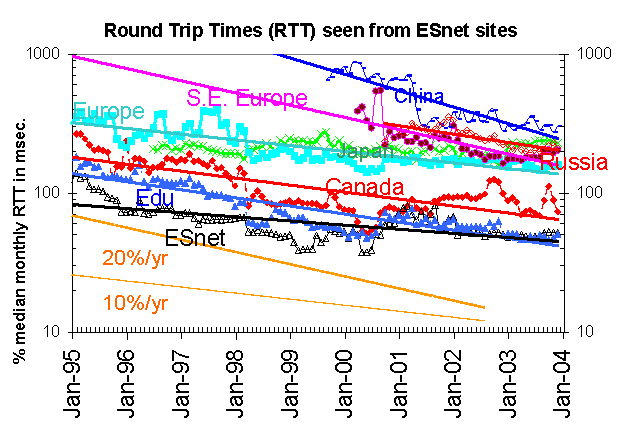 |
|
Figure 6: RTTs seen from ESnet sites to various regions of
the world. Edu indicates hosts in the .edu Top Level Domain (TLD), i.e.
mainly U.S. universities. The straight lines are fits to exponential
functions to help guide the eye. The orange lines are for 10 & 20%
improvements (reductions) in RTT/year. |
It is seen that Anglo American and European sites have been improving by
between 10 & 20% per year. Japan and Russia are improving at a slower rate and
S. E. Europe & mainland China at a faster rate. The improvements are due to
faster links (less time clocking the bits in and out of the network equipment),
faster routers and improved routes.
Fig. 7, shows the RTT from U.S. to the world in January 2000 and December
2003.
It also indicates which countries of the world contain sites that are monitored
(in the Jan 2000 map countries in green are not monitored, in the Dec 2003 apart
from the US unmonitored countries are left white).
|
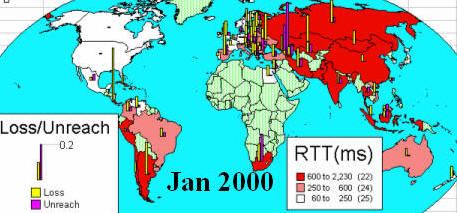
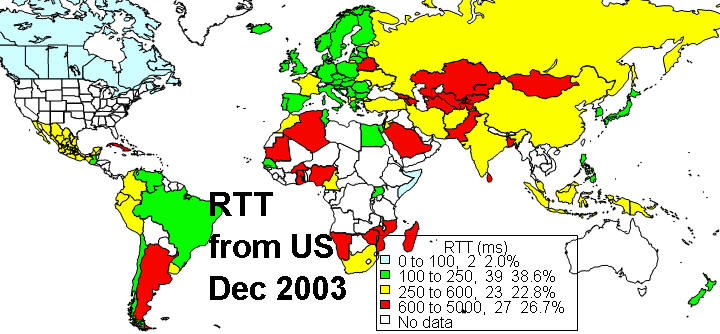
|
|
Figure 7: Average monthly RTT measured from U.S to various
countries of the world for January 2000 and August 2002. Countries shaded
green are not measured. |
It is seen that the number of countries with satellite links (> 600ms RTT
or dark red) has decreased markedly in the 3 years shown. Today satellite
links are used in places where it is hard or unprofitable to pull
terrestrial-lines (typically fibers) to.
Throughput
We also combine the loss and RTT measurements using throughput =
1460Bytes[Max Transmission Unit]/(RTT * sqrt(loss)) from [mathis]. The results are shown in Fig. 8.
The orange line shows a ~60% improvement/year or about a factor of 10 in 5 years.
|
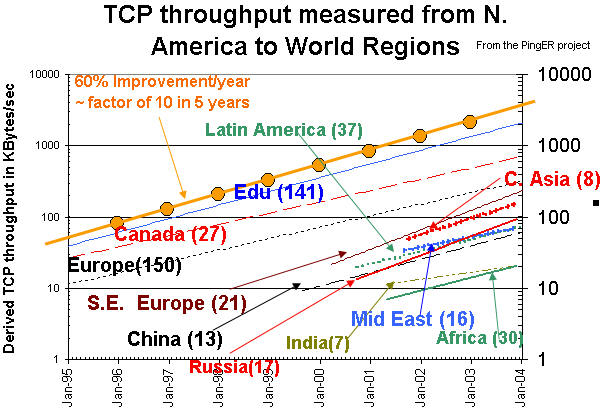 |
| Figure 8: Derived throughput as a function
of time seen from ESnet sites to various regions of the
world. The numbers in parentheses are the number of monitoring/remote host
pairs contributing to the data. The lines are exponential fits to the data. |
The data for several of the developing countries only extends back a few months
and so some care must be taken in interpreting the long term trends. With this
caveat, it can be seen that the
performances to regions such as S.E. Europe, Russia, and Central Asia are
catching up to the more developed countries, the Middle East, Africa, Latin
America and China only appear to be keeping up, while India appears to be
falling further behind. At the same time it is seen that the Middle East, Latin
America and China are about 6 years behind Europe with throughputs five or more
times less, and India and Africa are 8 years behind with throughputs 15 times
lower than those for Europe. In fact sites in Africa and India appear to
have throughputs less that that of a well connected (cable, DSL or ISDN) home in
Europe or Anglo America. For more on Africa see Connectivity
Mapping in Africa [ictp-jensen], African Internet
Connectivity [africa] and
Internet Performance to Africa [ejds-africa]). We are measuring mainly to
academic and research sites and not to many commercial sites. This may account
for the poor performance observed for India where there are many companies (such
as Oracle, Microsoft, Cisco) with probably excellent connectivity to which we
are not making measurements.View from Europe
To assist is developing a less N. American view of the Digital Divide, we
started adding many more hosts in developing countries to the list of hosts
monitored from CERN. We now have data going back for almost two and a half
years that enables us to make some statements about performance as seen from
Europe.
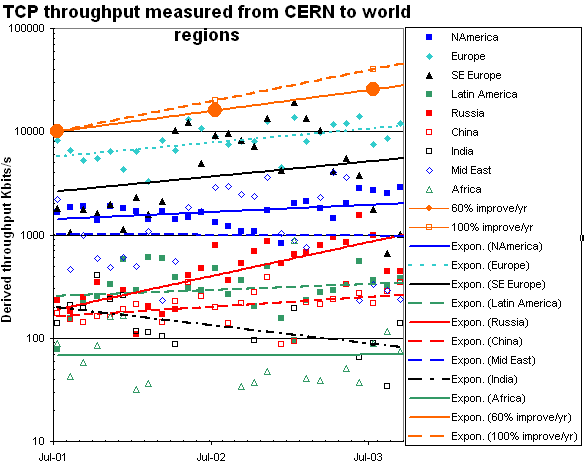 |
| Figure 9: Derived throughputs to various regions as seen from CERN. |
The sudden drop in throughput for the Middle East, is an artifact caused by
initially only monitoring hosts in 2 Middle East countries (Israel and Egypt)
with one (Israel) having markedly better performance (factor of 20) than
anywhere else in the Middle East. As we added hosts in more Middle East
Countries (starting in July 2003), the median dropped dramatically as Israel had
less effect. A similar effect can be seen for S.E. Europe where the dominating
countries were initially Croatia and Slovenia, that in July 2003 were joined by
Moldova, Macedonia and Romania. We expect to add several hosts to both regions
based on hosts being successfully monitored from SLAC. The orange lines indicate
improvements of 50% and 100% per year to help guide the eye. The other lines are
exponential fits to the data. It can be seen that there are large spread in the
data points from month to month. Apart from the special cases of the Middle East
and S.E. Europe mentioned above, the trends are similar to those seen from
ESnet: the improvements are between 50% and 100% per year; Russia, S. E. Europe
are catching up with N. America; Latin America and China are keeping up; Africa
and India are falling behind. There is insufficient data at the moment to
indicate how far the various regions are behind N. America or how long it will
take to catch up.
Variability of performance between and within regions
The throughput results, so far presented in this report, have been measured from
Anglo America or to a lesser extent from Europe. This is partially since there
is more data for a longer period available for the Anglo America monitoring
hosts. Table 3 shows the throughputd seen between monitoring and monitored hosts
in the major regions of the world. Each column is for monitoring hosts in a
given region, each row is for monitored hosts in a given region. The cells are
colored according to the median quality for the monitoring region/monitored
region pair. White is for derivedf throughputs > 1000 Kbits/s (good), blue for
<= 1000 Kbits/s & >500Kbits/s (acceptable), yellow for <= 500Kbits/s and > 200
Kbits/s, and magenta for <= 200Kbits/s (very poor to bad). The table is
ordered by decreasing average performance. The Monitoring countries are identified by the 2 character TLD. The .ORG site is JLab. The .NET sites are APAN in Japan
and the ESnet NOC at LBNL. The .GOV sites are ESnet sites (ANL, BNL, DOE-HQ,
FNAL, and LANL).
S. Asia is the Indian sub-continent; S.E. Asia is composed of measurements to
Indonesia, Malaysia, Singapore, Thailand and Vietnam.
| Table 3: Derived throughputs in kbits/s from monitoring hosts to
monitored hosts by region of the world for August 2003. |
|
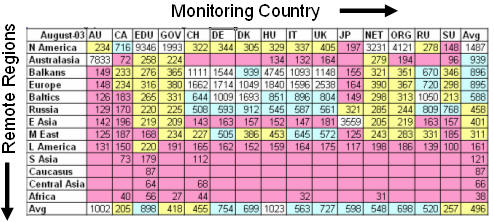 |
There are a couple of anomalies: the Mid East measurements are almost
entirely composed of measurements to Israel; the Caucasus measurements are to 2
countries with very different performance: Azerbaijan (50% loss) and Georgia (3%
loss). It can be seen that in general performance is good to acceptable. Regions
with very poor to bad performance include Africa, S. Asia (India), the Caucasus region
and S. America. Though not broken out here, performance to S.E. Asia
is generally poor.
To provide further insight into the variability in
performance for various regions of the world seen from SLAC Figure 10 shows
various statistical measures of the RTTs, losses and derived throughputs (the
definitions of the countries comprising a regions are also shown).
|
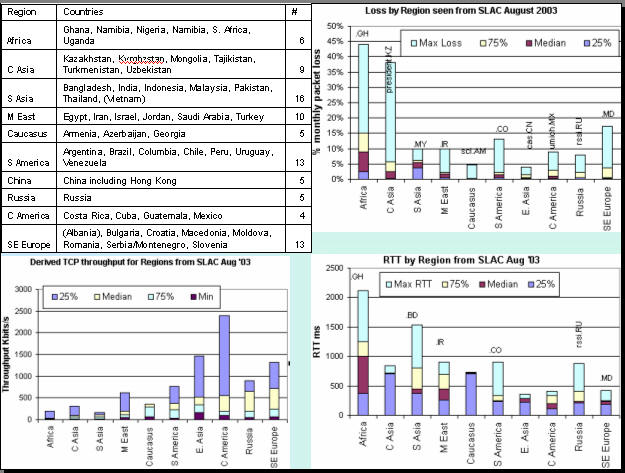 |
| Figure 10: Maximum, 75 percentile, median and 25 percentile RTTs,
losses and derived throughputs for various regions
measured from SLAC for August 2003. |
When there are large outliers, the sites/countries with the maxima are
indicated There are quite a lot of regions with outliers. Ghana (.GH) is
particularly poor for Africa. The Caucasus & C. Asia much more uniform now that
the virtual Silk Road project is in place, however, the virtual Silk Road does
not serve president.KZ so Kazakhstan (.KZ) stands out. For S. America,
performance is improving since the AMPATH project startede providing services.
However, AMPATH does not reach Colombia (.CO) at the moment. Other countries
that stand out as being particularly poor for their regions are Iran (.IR) and
Moldova (.MD), and within Russia (.RU) the RSSI has particularly poor
performance.
The PingER method of measuring throughput breaks down for high
speed networks due to the different nature of packet loss for ping compared to
TCP, and also since PingER only measures about 14,400 pings of a given
size/month between a given monitoring host/monitored host pair. Thus if the link
has a loss rate of better than 1/14400 the loss measurements will be inaccurate.
For a 100Byte packet, this is equivalent to a Bit Error Rate (BER) of 1 in 108,
and leading networks are typically better than this today (Jan 2004). This is partially the reason the ESnet and Abilene losses appear to have
leveled out since 2000 in Fig. 2. For example if the loss probability is <
1/14400 then we take the loss as being 0.5 packet to avoid a division by zero,
so if the average RTT for ESnet is 50msec then the maximum throughput we can use
PingER data to predict is ~ 1460Bytes*8bits/(0.050sec*sqrt(0.5/14400)) or ~
40Mbits/s and for an RTT of 200ms this reduces to 10Mbits/s.To address this challenge and to understand and provide monitoring of high
performance throughput between major sites of interest to HEP and the Grid, we
developed the IEPM-BW monitoring infrastructure and toolkit. There are about 10 monitoring hosts and about 50 monitored hosts in 9
countries (CA, CH, CZ, FR, IT, JP, NL, UK, US). Both application (file copy and
file transfer) and TCP throughputs are measured.
These measurements indicate that throughputs of several hundreds of Mbits/s
are achievable on today's production academic and research networks, using
common off the shelf hardware, standard network drivers, TCP stacks etc.,
standard packet sizes etc. Achieving these levels of throughput requires care in
choosing the right configuration parameters. These include large TCP buffers and
windows, multiple parallel streams, sufficiently powerful cpus (typically better
than 1 MHz/Mbit/s), fast enough interfaces and busses, and a fast enough link
(> 100Mbits/s) to the Internet. In addition for file operations one needs
well designed/configured disk and file sub-systems.
Though not strictly monitoring, there is currently much activity in
understanding and improving the TCP stacks (e.g. [floyd], [low], [ravot]). In
particular with high speed links (> 500Mbits/s) and long RTTs (e.g.
trans-continental or trans-oceanic) today's standard TCP stacks respond poorly
to congestion (back off too quickly and recover too slowly). To partially
overcome this one can use multiple streams or in a few special cases large
(>> 1500Bytes) packets. In addition new applications ([bbcp], [bbftp],
[gridftp]) are being developed to allow use of larger windows and multiple
streams as well as non TCP strategies ([tsnami]). Also there is work to
understand how to improve the operating system configurations
[os] to improve the throughput performance. As it becomes increasingly possible
to utilize more of the available bandwidth, more attention will need to be paid
to fairness and the impact on other users (see for example [coccetti] and [bullot]). Besides ensuring the fairness of TCP
itself, we may need to deploy and use quality of service techniques such as QBSS
[qbss] or TCP stacks that back-off prematurely hence enabling others to utilize
the available bandwidth better [kuzmanovic]. These subjects will be covered in more detail in the companion ICFA-SCIC
Advanced Technologies Report. We note here that monitoring infrastructures such
as IEPM-BW can be effectively used to measure and compare the performance of TCP
stacks, measurement tools, applications and sub-components such as disk and file
systems and operating systems in a real world environment.
Pinger and IEPM-BW are excellent systems for monitoring the general health
and capability of the existing networks used worldwide in HEP. However, we need
additional end-to-end tools to provide individuals with the capability to
quantify their network connectivity along specific paths in the network and also
easier to use top level navigation/drill-down tools. The former are
needed to both ascertain the user's current network capability as well as to
identify limitations which may be impeding the users ultimate (expected) network
performance. The latter are needed to simplify finding the relevant data.
Most HEP users are not a "network wizard" and don't wish to become one.
Because of HEP's critical dependence upon networks to enable their global
collaborations and grid computing environments, it is extremely important that
more user specific tools be developed to support these physicists.
Efforts are underway in the HENP community, in conjunction with the
Internet2 End-to-End (E2E) Performance
Initiative [E2Epi], to develop and deploy a network measurement and diagnostic
infrastructure which includes end hosts as test points along end-to-end paths in
the network. The E2E
piPEs project [PiPES], the NLANR/DAST
Advisor project [Advisor] and the EMA
(End-host Monitoring Agent) [EMA] are all working together to help develop an
infrastructure capable of making on demand or scheduled measurements along
specific network paths and storing test results and host details for future
reference in a common data architecture. The information format will utilize the
GGF NMWG [NMWG] schema to provide portability for the results. This information could
be immediately used to identify common problems and provide solutions as well as
to acquire a body of results useful for baselining various combinations of
hardware, firmware and software to define expectations for end users.
A primary goal is to provide as "lightweight" a client component as possible
to enable widespread deployment of such a system. The EMA Java Web Start client
is one example of such a client, and another is the
Network Diagnostic Tester (NDT)
tool [NDT]. By using Java and Java Web Start, the most
current testing client can be provided to end users as easily as opening a web
page. The current version supports both Linux and Windows clients.
Details of how the data is collected, stored, discovered and queried are
being worked out. A demonstration of a preliminary system is being shown at the
Internet2 Joint-techs meeting in
Hawaii on January 25th, 2004.
The goal of easier to use top level drill down navigation to the measurement
data is being tackled by MonALISA
[MonALISA] in collaboration with the IEPM project.
A long term goal is to merge Pinger and IEPM-BW results into a larger
distributed database architecture for use by grid scheduling and network
diagnostic systems. By combining general network health and performance
measurement with specific end-to-end path measurements we can enable a much more
robust, performant infrastructure to support HEP worldwide and help bridge the
Digital Divide.
Recent studies of HEP needs, for example the TAN Report (http://gate.hep.anl.gov/lprice/TAN/Report/TAN-report-final.doc)
have focused on communications between developed regions such as Europe and
Anglo America. In such reports packet loss less than 1%, vital for
unimpeded interactive log-in, is assumed and attention is focused on bandwidth
needs and the impact of low, but non-zero, packet loss on the ability to exploit
high-bandwidth links. The PingER results show clearly that much of the
world suffers packet loss impeding even very basic participation in HEP
experiments and points to the need for urgent action.
The PingER throughput predictions based on the Mathis
formula assume that throughput is mainly limited by packet
loss. The 60% per year growth curve in figure 8 is somewhat lower than the 79% per year growth in future needs
that can be inferred from the tables in the TAN Report. True throughput
measurements have not been in place for long enough to measure a growth
trend. Nevertheless, the throughput measurements, and the trends in
predicted throughput, indicate that current attention to HEP needs between
developed regions could result in needs being met. In contrast, the
measurements indicate that the throughput to less developed regions is likely to
continue to be well below that needed for full participation in future
experiments.
Various economic indicators have been developed by the U.N. and the
International Telecommunications Union (ITU). It is interesting to see how well
the PingER performance indicators correlate with the economic indicators. The
comparisons are particularly interesting in cases where the agreement is poor,
and may point to some interesting anomalies or suspect data.
The Human Development Index (HDI) is a summary measure of human development
(see
http://hdr.undp.org/reports/global/2002/en/ ). It measures the average
achievements in a country in three basic dimensions of human development:
- A long and healthy life, as measured by life expectancy at birth
- Knowledge, as measured by the adult literacy rate (with two-thirds weight)
and the combined primary, secondary and tertiary gross enrolment ratio (with
one-third weight)
- A decent standard of living, as measured by GDP per capita (PPP US$).
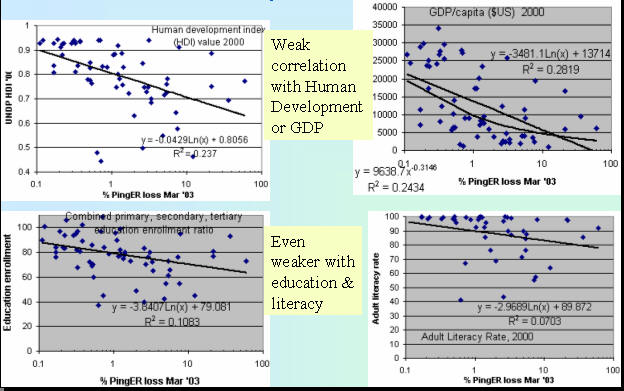 |
| Figure 11: Comparisons of PingER losses seen from N.
America to various countries versus various U.N. Development Programme (UNDP)
indicators. |
The Network Readiness Index (NRI) from the Center for International
Development, Harvard University (see
http://www.cid.harvard.edu/cr/pdf/gitrr2002_ch02.pdf ) is a major
international assessment of countries’ capacity to exploit the opportunities
offered by Information and Communications Technologies (ICTs), i.e. a
community’s potential to participate in the Networked World of the future. The
goal is to construct a network use component that measures the extent of current
network connectivity, and an enabling factors component that measures a
country’s capacity to exploit existing networks and create new ones. Network use
is defined by 5 variables related to the quantity and quality of ICT use.
Enabling factors are based on Network access, network policy, networked society
and the networked economy.
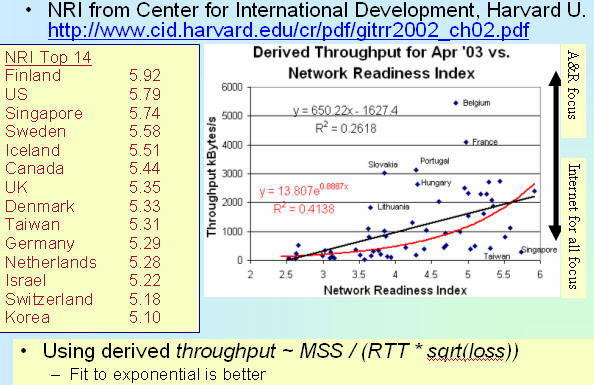 |
| Figure 12: PingER throughputs measured from N. America vs. the Network
Readiness Index. |
Some of the outlying countries are identified by name. Countries at the
bottom right of the right hand graph may be concentrating on Internet access for
all, while countries in the upper right may be focusing on excellent academic &
research networks.
The Digital Access Index (DAI) created by the ITU combines eight variables,
covering five areas, to provide an overall country score. The areas are
availability of infrastructure, affordability of access, educational level,
quality of ICT services, and Internet usage. The results of the Index point to
potential stumbling blocks in ICT adoption and can help countries identify their
relative strengths and weaknesses.
|
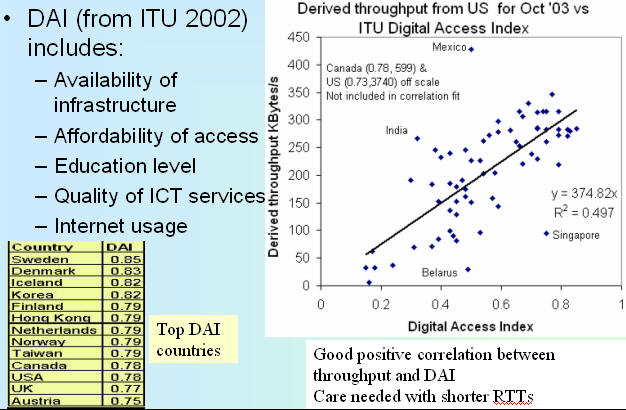 |
| Figure 13: PingER derived throughput vs. the ITU Digital Access Index
for PingER countries monitored from the U.S. |
Since the PingER Derived Throughput is linearly proportional to RTT,
countries close to the U.S. (i.e. the U.S., Canada and Mexico) may be expected
to have elevated Derived Throughputs compared to their DAI. We thus do not use
the U.S. and Canada in the correlation fit, and they are also off-scale in
Figure 13. Mexico is included in the fit, however it is also seen to have an
elevated Derived Throughput. Less easy to explain is India's elevated Derived
Throughput. This maybe due to the fact that we monitor university and research
sites which may have much better connectivity than India in general. Belarus on
the other hand apparently has poorer Derived Throughput than would be expected
from its DAI. This could be an anomaly for the one host currently monitored in
Belarus and thus illustrates the need to monitor multiple sites in a developing
country.
The United Nations Development Programme (UNDP) introduced the Technology
Achievement Index (TAI) to reflects a country's capacity to participate in the
technological innovations of the network age. The TAI
aims to capture how well a country is creating and diffusing technology and building
a human skill base. It includes the following dimensions: Creation of technology
(e.g. patents, royalty receipts); diffusion of recent innovations (Internet hosts/capita,
high & medium tech exports as share of all exports); Diffusion of old
innovations (log phones/capita, log of electric consumption/capita); Human
skills (mean years of schooling, gross enrollment in tertiary level in
science, math & engineering). Figure 14 shows December 2003's derived
throughput measured from the U.S. vs. the TAI. The correlation is seen to be
positive and medium to good. The US and Canada are excluded since the losses are
not accurately measureable by PingER and the RTT is small. Hosts in well
connected countries such as Finland, Sweden, Japan also have their losses poorly
measured by PingER and since they have long RTTs the derived throughput is
likely to be low using the Mathis formula and if no packets are lost then
assuming a loss of 0.5 packets in the 14,400 sent to a host in a month.
|
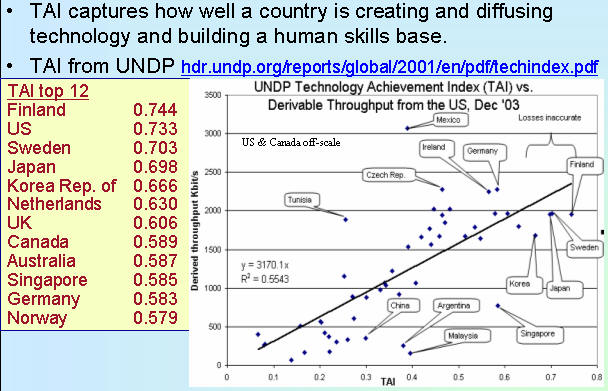 |
|
Figure 14: PingER derived throughputs vs. the UNDP
Technology Achievement Index (TAI) |
We have extended the measurements to cover more developing countries and to
increase the number of hosts monitored in each developing country. As a result
the number of countries monitored has increased by about 24% to over 100.
We have also spent much time working with contacts to unblock pings to their
sites (as mentioned above ~15% of hosts pingable in July 2003 were no longer pingable in December 2003). It is unclear how cost-effective this activity is. It can take many
emails to explain the situation, sometimes requiring restarting when the problem
is passed to a more technically knowledgeable person. Even then there are
several unsuccessful cases where even after many months of emails and the best
of intentions the pings remain blocked. Two specific cases are for all
university sites in Vietnam and Australia.
Even finding knowledgeable contacts, explaining what is needed and following
up to see if the recommended hosts are pingable, is quite labor intensive. More
recently we have had more success by using Google to search for university web
sites in specific TLDs. The downside is that this way we do not have any
contacts with specific people with whom we can deal in case of problems.
We worked with the eJDS/ICTP to produce a web site (http://www.ejds.org/) dedicated to PingER and
the Digital Divide. The attention of HEP to the Digital Divide was encouraged by
the presentation of a paper at CHEP03 in San Diego. We worked with the ICTP to
organize the very successful second Open Round Table on
Developing Countries Access to Scientific Knowledge: Quantifying the Digital
Divide 23-24 November Trieste, Italy, attended and presented 3 talks. As
part of this a poster was created and the proceeding were distributed. Wider
distribution of the results was made by including slides in presentations at the RSIS by Harvey Newman, Hans Hoffman and the director of ICTP.
With eJDS we produced an A3 poster for the WSIS/RSIS in Geneva. We also attended
the SIS at Palexpo, Geneva in December 2003 and gave multiple demonstrations of
"PingER: Measuring the Digital Divide" at various venues including
CHEP03, RIPE, ICTP, SLAC, BaBar, SC2003 and SIS.
We made contact with International organizations including the UN, UNESCO and
Soros foundation and made them aware of the eJDS/PingER monitoring
project. Hilda Cerdeira of ICTP is discussing with UNESCO about possible follow
up and collaboration, and with IDRC (see
http://www.idrc.ca/) we are discussing a proposal to extend the
monitoring of Africa.
Publications:
- Developing countries and the global science web, Hilda Cerdeira,
Enrique Canessa, Carlo Fonda & R. Les Cottrell, CERN Courier Vol 43, Number
10, Decxember 2003. Available at
http://www.cerncourier.com/main/article/43/10/18
- Measuring the Digital Divide with PingER, R. Les Cottrell and
Warren Matthews, Developing Countries Access to Scientific Knowledge:
Quantifying the Digital Divide, ICTP Trieste, October 2003; also
SLAC-PUB-10186.
- PingER History and Methodology R. Les Cottrell and Connie Logg,
Developing Countries Access to Scientific Knowledge: Quantifying the Digital
Divide, ICTP Trieste, October 2003; also SLAC-PUB-10187.
- Internet Performance to Africa R. Les Cottrell and Enrique Canessa,
Developing Countries Access to Scientific Knowledge: Quantifying the Digital
Divide, ICTP Trieste, October 2003; also SLAC-PUB-10188
- Monitoring the Digital Divide, E. Canessa, H. A. Cerdeira, W.
Matthews, R. L. Cottrell, SLAC-PUB-9730, CHEP 2003, San Diego, March 2003.
Presentations:
-
PingER: Measuring the Digital Divide, demonstration presented by Les
Cottrell at the SIS Exposition, Palexpo/Geneva December 2003.
-
PingER: a lightweight active end-to-end network monitoring tool/project
presented by Les Cottrell at the RIPE 46 Meeting, Amsterdam Sept. 2003.
- Internet End-to-end Performance Monitoring (IEPM) and the PingER project
(powerpoint
or
PDF). Presented by Warren Matthews at
the National
Collaboratory Middleware and Network
-
Digital Divide and PingER, presented by Les Cottrell at the ICFA/SCIC
meeting, July 2003. Also available in
ppt.
-
Quantifying the Digital Divide, presentation by Les Cottrell to the
ICFA-SCIC group, May 2003
-
Quantifying the Digital Divide, presented by Warren Matthews at the
Internet2 Spring Members Meeting, Arlington, VA, April 2003, at the Hard to
Network Places BOF.
PPT
Internet performance is improving each year with losses typically improving
by 40-50% per year and RTTs by 10-20% and, for some regions such as S. E. Europe,
even more. Geosynchronous satellite connections are still important to countries
with poor telecommunications infrastructure or in remote land-locked regions. In general for HEP countries
satellite links are being replaced with land-line links with improved
performance (in particular for RTT).
Links between the more developed regions including Anglo America, Japan and
Europe are much better than elsewhere (5 - 10 times more throughput achievable).
Regions such as S. E. Europe, Russia and Central Asia appear to be catching up
with developed regions such as Europe. At the present rate of progress S. E.
Europe should catch up in a couple of years and Russia, Central Asia and the
Caucasus in the next five to seven years. China, the Middle East and Latin
America are improving at a similar rate to the more developed regions. However,
India and Africa are further behind and India in particular appears to be
falling further behind. Though there is less extensive data, similar results are
seen in measurements made from Europe. Countries/regions with particularly bad
connections include the the Caucasus, India, and Africa. There has been a
dramatic improvement in the Internet performance for most of the world's
connected population in the last 2 years.
There is a positive correlation
between the various economic and development indices. Besides being useful in
their own right these indices are an excellent way to illustrate anomalies and
for pointing out measurement/analysis problems. The large variations between
sites within a given country illustrate the need for careful checking of the
results and the need for multiple sites/country to identify anomalies. PingER
has increased its coverage by over 25% (in number of countries) in the last year
despite increasing prevalence of ping blocking. As a result a larger fraction (~
90%) of the world's online connected population is now represented by the PingER
data.
The ICFA-SCIC "Digital Divide" report will dwell in more detail on many of
the issues of the performance differences for the developed and less
well-developed countries.
The monitoring covers most countries with formal HEP programs appearing in
the "Pocket Diary for Physicists". The monitoring should be extended to include
>=2 hosts in each Developing Country
with a formal HEP program.
There is also interest from ICFA, ICTP and others to extend
the monitoring further to countries with no formal HEP programs, but where there
are needs to understand the Internet connectivity performance in order to aid
the development of science. Africa is a region with many such countries.
Extend the monitoring of developing countries from Europe by increasing the
number of sites/hosts in developing countries monitored from CERN.
The collaboration with the ICTP has been very fruitful to bring in contacts
from developing nations with scientific interests. We recommend to continue
working with the ICTP/eJDS project to further publicise, and gather new entries
for, the monitoring of developing countries. Special emphasis will be done to
the incorporation of African countries and, in particular, sites in remote areas
in the monitoring.
We should ensure there are >=2 remote sites monitored in each Developing Countries. All results should continue to be made available publicly
via the web, and publicized to the HEP community and others. Typically HENP leads other sciences in its needs
and developing an understanding and solutions. The outreach from HENP to other
sciences is to be encouraged. The results should continue to be publicized more widely,
for example at the CHEPREO meeting in Rio de Janiero in February 2003.
We need assistance from ICFA and others to find sites to monitor and contacts
in the following countries:
- Latin America: Venezuela (need > 1 host/country), Costa Ricah*, Honduras, El Salvador, Belize, Panama,
Bolivia (have none)
- Vietnam*
- Belarush (need > 1)
- Africa: Burkino Faso,
Egypt, Ghana, Malawi, Nigeria, Senegal, Somalia (need > 1/country), Kenya,
Libya, Nigeria, Sudan (have none)
Depending on availability of funding:
- simplify and where possible automate the procedures to analyze and create
the summary statistical information (graphs and tables seen in the current
report) at regular intervals;
- develop automated methods to discover non-responsive hosts, make extra
tests to pin-point reasons for non-responsiveness, and report to administrator
together with contact email addresses.
Although not a recommendation per se, it would be disingenous to finish
without noting the following. SLAC & FNAL are the leaders in the PingER
project. The funding for the PingER effort has come from the DoE MICS office
since 1997, however it terminated at the end of the September 2003, since it was
being funded as research and the development is no longer regarded as a research
project. To continue
the effort at a minimum level (maintain data collection, explain needs, reopen
connections, open firewall blocks, find replacement hosts, make limited special
analyses, prepare & make presentations, respond to questions) would probably require central funding at a level of about 50% of a
Full Time Equivalent (FTE) person, plus travel. To extend the and enhance the
project (extend the code for new environment (more countries, more data
collections), fix known non-critical bugs, improve visualization, automate
reports generated by hand today, find new country site contacts, add route
histories and visualization, automate alarms, update web site for better
navigation, add more Developing Country monitoring sites/countries, improve code portability)
would take an additional 50% of an FTE (for a total of 1 FTE plus travel). Without funding, the future of PingER and reports
such as this one is unclear, and the level of effort sustained in 2003 will not
be possible in 2004. Many agencies/organizations have expressed interest (e.g
DoE, ESnet, NSF, ICFA, ICTP, IDRC, UNESCO) in this work but none can (or are
allowed to) fund it. We are currently seeking funding from the Canadian IDRC to
assist in extending the monitoring to Africa.
The following table lists the 104
countries currently (January 1st 2004) in the PingER database. Such countries contain
zero (Australian Academic hosts appear to have pings blocked to them at the
Washington GigaPoP in Seattle, the only host in Costa Rica that we used to
monitor objected, the Vietnam hosts we used to monitor now block pings, and we
are unable to find a host taht does not block pings) or more
sites that are being or have been monitored by PingER from SLAC. The number in
the columns to the right of the country name are the number of hosts monitored
in that country. The number cell is colored red for zero hosts, yellow for one
host for the country and green for 2 or more hosts for the country. The 45
countries marked in orange are developing countries for which we only monitor
one site in the country.
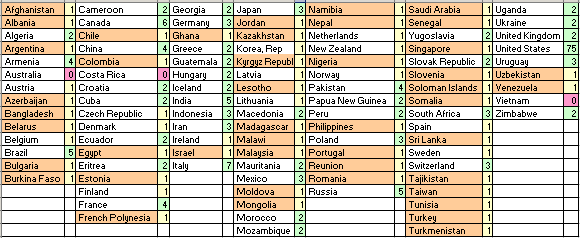
[Advisor]
http://dast.nlanr.net/Projects/Advisor/
[africa] Mike Jensen, "African Internet
Connectivity". Available http://www3.sn.apc.org/africa/afrmain.htm
[africa-rtm] Enrique Canessa,
"Real time network monitoring in Africa -
A proposal - (Quantifying the Digital; Divide)". Available
http://www.ictp.trieste.it/~ejds/seminars2002/Enrique_Canessa/index.html
[bbcp] Andrew Hanushevsky, Artem Trunov, and Les Cottrell, "P2P Data Copy
Program bbcp", CHEP01, Beijing 2002. Available at
http://www.slac.stanford.edu/~abh/CHEP2001/p2p_bbcp.htm
[bbftp] "Bbftp".
Available http://doc.in2p3.fr/bbftp/.
[bullot] "TCP Stacks Testbed", Hadrien Bullot and R. Les Cottrell. Avialble at
http://www-iepm.slac.stanford.edu/bw/tcp-eval/
[coccetti] "TCP STacks on Production Links", Fabrizzio Coccetti and R. Les
Cottrell. Available at
http://www-iepm.slac.stanford.edu/monitoring/bulk/tcpstacks/
[E2Epi] http://e2epi.internet2.edu/
[ejds-email] Hilda Cerdeira and the
eJDS Team, ICTP/TWAS Donation Programme, "Internet Monitoring of Universities
and Research Centers in Developing Countries". Available
http://www.slac.stanford.edu/xorg/icfa/icfa-net-paper-dec02/ejds-email.txt
[ejds-africa] "Internet Performance to Africa" R. Les Cottrell and Enrique
Canessa, Developing Countries Access to Scientific Knowledge: Quantifying the
Digital Divide, ICTP Trieste, October 2003; also SLAC-PUB-10188. Available
http://www.ejds.org/meeting2003/ictp/papers/Cottrell-Canessa.pdf
[ejds-pinger] "PingER History and Methodology", R. Les Cottrell, Connie Logg and
Jerrod Williams. Developing Countries Access to Scientific Knowledge:
Quantifying the Digital Divide, ICTP Trieste, October 2003; also SLAC-PUB-10187.
Available
http://www.ejds.org/meeting2003/ictp/papers/Cottrell-Logg.pdf
[EMA] http://monalisa.cern.ch/EMA/
[floyd] S. Floyd, "HighSpeed TCP for Large Congestion Windows", Internet
draft draft-floyd-tcp-highspeed-01.txt, work in progress, 2002. Available
http://www.icir.org/floyd/hstcp.html
[gridftp] "The GridFTP Protocol
Protocol and Software". Available
http://www.globus.org/datagrid/gridftp.html
[host-req] "Requirements for WAN Hosts being Monitored", Les Cottrell and Tom
Glanzman. Available at
http://www.slac.stanford.edu/comp/net/wan-req.html
[icfa-98] "May 1998 Report of the ICFA NTF Monitoring Working Group".
Available http://www.slac.stanford.edu/xorg/icfa/ntf/
[icfa-mar02]
"ICFA/SCIC meeting at CERN in March 2002". Available
http://www.slac.stanford.edu/grp/scs/trip/cottrell-icfa-mar02.html
[icfa-jan03] "January 2003 Report of the ICFA-SCIC Monitoring Working Group".
Available http://www.slac.stanford.edu/xorg/icfa/icfa-net-paper-dec02/
[iepm]
"Internet End-to-end Performance Monitoring - Bandwidth to the World Project".
Available http://www-iepm.slac.stanford.edu/bw
[ictp] Developing
Country Access to On-Line Scientific Publishing: Sustainable Alternatives,
Round Table meeting held at ICTP Trieste, Oct 2002. Available
http://www.ictp.trieste.it/~ejds/seminars2002/program.html
[ictp-jensen]
Mike Jensen, "Connectivity
Mapping in Africa", presentation at the ICTP Round Table on Developing
Country Access to On-Line Scientific Publishing: Sustainable Alternatives at
ITCP, Trieste, October 2002. Available
http://www.ictp.trieste.it/~ejds/seminars2002/Mike_Jensen/jensen-full.ppt
[ictp-rec] RECOMMDENDATIONS
OF the Round Table held in Trieste to help bridge the digital divide.
Available
http://www.ictp.trieste.it/ejournals/meeting2002/Recommen_Trieste.pdf
[kuzmanovic] "HSTCP-LP: A Protocol for Low-Priority Bulk Data Transfer in
High-Speed High-RTT Networks", Alexander Kuzmanovic, Edward Knightly and R. Les
Cottrell. Available at
http://dsd.lbl.gov/DIDC/PFLDnet2004/papers/Kuzmanovic.pdf
[low] S. Low, "Duality model of TCP/AQM + Stabilized Vegas". Available
http://netlab.caltech.edu/FAST/meetings/2002july/fast020702.ppt
[mathis] M.
Mathis, J. Semke, J. Mahdavi, T. Ott, "The Macroscopic
Behavior of the TCP Congestion Avoidance Algorithm",Computer
Communication Review, volume 27, number 3, pp. 67-82, July 1997
[MonALISA]
http://monalisa.cacr.caltech.edu/
[NDT]
http://miranda.ctd.anl.gov:7123/
[NMWG] http://www-didc.lbl.gov/NMWG/
[nua] NUA
Internet Surveys, "How many
Online". Available http://www.nua.ie/surveys/how_many_online/
[os] "TCP
Tuning Guide". Available http://www-didc.lbl.gov/TCP-tuning/
[pinger]
"PingER". Available http://www-iepm.slac.stanford.edu/pinger/;
W. Matthews and R. L. Cottrell, "The PingER Project: Active Internet Performance
Monitoring for the HENP Community", IEEE Communications Magazine Vol. 38 No. 5
pp 130-136, May 2002.
[pinger-deploy] "PingER Deployment". Available http://www.slac.stanford.edu/comp/net/wan-mon/deploy.html
[PiPES] http://e2epi.internet2.edu/
[qbss] "SLAC QBSS Measurements". Available
http://www-iepm.slac.stanford.edu/monitoring/qbss/measure.html
[ravot] J. P.
Martin-Flatin and S. Ravot, "TCP Congestion Control in Fast Long-Distance
Networks", Technical Report CALT-68-2398, California Institute of Technology,
July 2002. Available
http://netlab.caltech.edu/FAST/publications/caltech-tr-68-2398.pdf
[tsunami]
"Tsunami". Available
http://ncne.nlanr.net/training/techs/2002/0728/presentations/pptfiles/200207-wallace1.ppt
[tutorial] R. L. Cottrell, "Tutorial on Internet Monitoring & PingER at
SLAC". Available http://www.slac.stanford.edu/comp/net/wan-mon/tutorial.html
[un]
"United Nations Population Division World Population Prospects Population
database". Available http://esa.un.org/unpp/definition.html
1. In special cases, there is an option to reduce the network impact to ~
10bits/s per monitor-remote host pair.
2. Since North America officially includes Mexico, we follow the Encyclopedia
Britannica recommendation and use the terminology Anglo America (US + Canada)
and Latin America. Unfortunately many of the figures use the term N. Amerrica
for what should be Anglo America.
h. These countries appear in the Particle
Data Group diary and so would appear to have HENP programs.
*. These
countries are no longer monitored, usually the host no longer exists, or pings
are blocked.

















